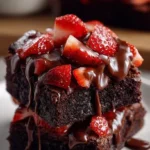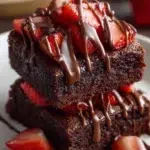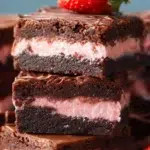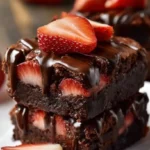Imagine a dessert so airy and creamy it practically melts on your tongue. That’s what the Light & Fluffy Yogurt Cloud Cake offers—a heavenly mix of yogurt’s tang and a sponge cake’s softness. Whether you’re aiming for a lighter treat or just something different from your usual chocolate cake, this cloud cake is a fresh and satisfying alternative.
It’s incredibly easy to make with minimal ingredients, and the texture is unforgettable. In this complete guide, you’ll learn everything about crafting the perfect yogurt cloud cake—from ingredients, baking tricks, and health benefits to presentation and storage. Ready to float into flavor? Let’s dive in.
Table of Contents
Looking for inspiration? Try this peach cake variation that’s also light and fruity.
Introduction to Light & Fluffy Yogurt Cloud Cake
What is a yogurt cloud cake?
A yogurt cloud cake is a Japanese-inspired dessert known for its pillowy soft, melt-in-your-mouth texture. Unlike traditional cakes, this one uses whipped egg whites folded into a yogurt-based batter. The result? A creamy, cloud-like cake with a delicate tang and a subtle sweetness. Think of it as the perfect cross between a souffle and a sponge cake—but with yogurt as the star.
It’s usually baked in a water bath to help maintain its fluffiness and avoid browning too much. The final touch is a light dusting of powdered sugar, making it look as dreamy as it tastes.
Why it’s trending among dessert lovers
There’s a reason this cake is going viral. With more people focusing on lighter, lower-calorie treats, the yogurt cloud cake hits all the marks. It’s gluten-free friendly (with modifications), naturally protein-rich thanks to the yogurt and eggs, and doesn’t require frosting or heavy decorations.
Plus, its aesthetic appeal is undeniable—simple, snowy, and elegant. Don’t miss our chocolate custard cake recipe for a similar light-yet-creamy dessert experience.
Ingredients That Make It Light & Fluffy
Role of yogurt in creating a cloud-like texture
Yogurt does more than enhance flavor—it plays a key role in creating a soft, tender texture. Its smooth and slightly acidic nature helps tenderize the batter and gives the cake its signature creaminess. When baked, yogurt helps the cake retain moisture without being dense.
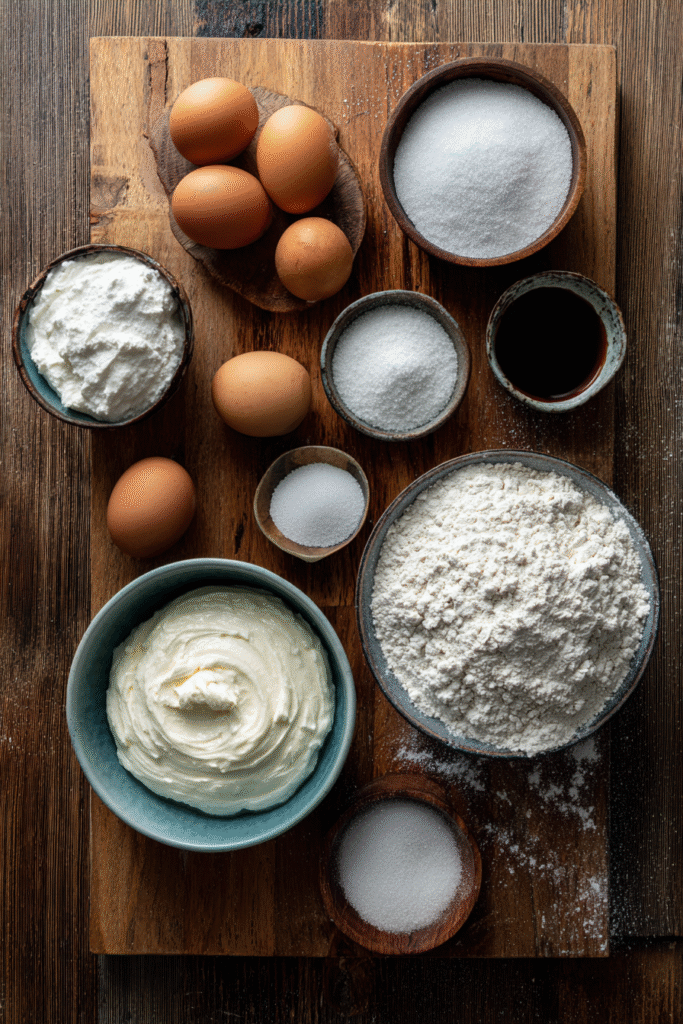
Choosing full-fat yogurt gives the best result, but if you’re aiming for a healthier twist, low-fat versions work too. You can use flavored yogurts, but keep an eye on the added sugars they may contain.
Discover great ideas like using Greek yogurt in baking over at this yogurt-based cookie recipe.
Egg whites and their impact on fluffiness
Here’s where the real magic happens. Egg whites are beaten until stiff peaks form, then gently folded into the batter. This process traps air and allows the cake to rise and set like a soft cloud.
The trick is in the folding. You don’t want to deflate the egg whites—gentle swirling and cutting motions work best. This method creates the airy lift that defines a true yogurt cloud cake.
If you’ve ever had a Japanese cheesecake, this method will feel familiar. That’s because both cakes rely on the same meringue-style technique.
Learn more about why eggs matter in baking in our ultimate creamy dessert guide.
Step-by-Step Instructions for Making Yogurt Cloud Cake
Preparing the batter with perfect consistency
To get the dreamiest texture, start with room-temperature ingredients. This helps them mix more evenly. Here’s what you’ll typically need:
- 3 eggs (separated)
- ½ cup plain or Greek yogurt
- 3 tablespoons flour or cornstarch (for a gluten-free option)
- ¼ cup sugar
- 1 teaspoon vanilla extract
- A pinch of salt
Start by whisking the yolks with yogurt until creamy. Then sift in the flour (or starch) and mix until smooth. Add vanilla and a pinch of salt for flavor depth.
This base should be lump-free, glossy, and thick. Don’t overmix—it’s important to preserve the airiness for the next step.
Whipping egg whites and folding techniques
In a clean bowl, beat the egg whites until they turn foamy. Slowly add the sugar, whipping continuously until stiff peaks form. The mixture is ready when the peaks stand tall without collapsing when the whisk is lifted.
Now, fold a small amount of the whipped whites into your yogurt batter to lighten it up. Carefully fold in the remaining mixture with a spatula, using gentle motions to keep the batter light and airy. The motion should be slow and deliberate—overmixing will flatten the batter.
Finally, pour the mixture into a parchment-lined pan, tap it gently to remove air bubbles, and bake using a water bath. This prevents cracks and helps maintain that cloud-soft texture.
Check out this easy water-bath cake recipe to learn more about steam baking for delicate desserts.
Choosing the Right Yogurt for the Best Texture and Taste
Greek yogurt vs regular yogurt in baking
Greek yogurt gives the cloud cake a denser, richer texture with added protein. It’s thicker and more strained than regular yogurt, so it results in a more compact yet creamy cake.
On the other hand, regular yogurt offers more moisture and a softer bite. If you prefer your cake lighter and meltier, this might be the better option.
If your Greek yogurt is too thick, just thin it out with a tablespoon of milk or water before mixing it in. This ensures the batter won’t get too heavy.
Looking for inspiration? Try this yogurt-forward Biscoff cinnamon roll recipe for more rich, creamy ideas.
Tips for dairy-free or plant-based substitutions
For those avoiding dairy, coconut yogurt or almond yogurt work great as alternatives. These plant-based options still add creaminess but introduce unique flavors. Coconut yogurt lends a light tropical flavor that complements fruity toppings beautifully.
You can also replace egg whites with aquafaba (the liquid from canned chickpeas) to make it fully vegan. Whip it just like egg whites for similar fluffiness.
Just remember to keep sweetness and moisture in check—some dairy-free yogurts are already sweetened, so adjust sugar accordingly.
Don’t miss our guide on how to work with soft and chewy textures in baked goods.
Baking Techniques and Temperature Secrets
Oven temperature and timing for fluffy results
Baking this cake is all about balance. Aim for perfectly cooked—not overdone—to maintain the ideal texture and flavor. The ideal baking temperature is 300°F (150°C), low and slow, for about 50–60 minutes.
Use a water bath (place your cake pan inside a larger tray filled with hot water) to create gentle, even heat. This prevents sudden rising and collapsing and gives the cake that ultra-smooth, fluffy texture.
Avoid opening the oven door too often—temperature fluctuations can cause the cake to sink. Let the cake cool gradually in the oven after turning it off. This step helps it settle without cracking or shrinking.
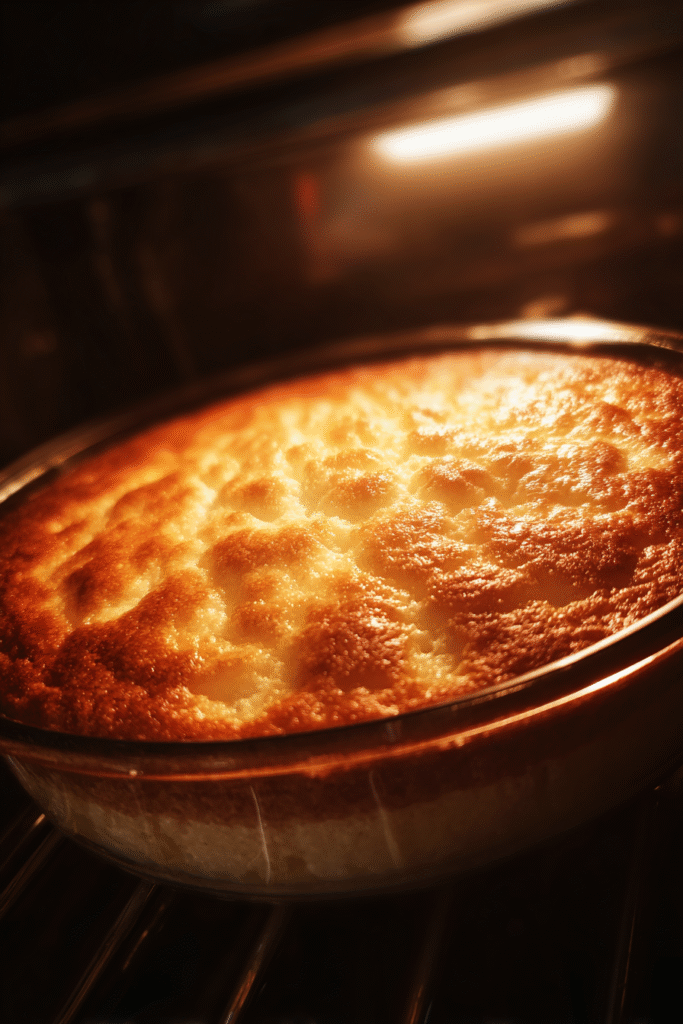
Learn more about oven temp control in our perfect meatloaf temperature guide (yes, the principle applies to baking delicate cakes too).
Tips for preventing collapse or cracking
Even the fluffiest cakes can fall flat if not treated right. Here are some expert tips:
- Always use room-temperature ingredients.
- Whip the egg whites to stiff—not dry—peaks.
- Gently fold to keep air in the batter.
- Avoid overbaking. A jiggle in the center is okay; it will firm up while cooling.
- Let it rest inside the oven with the door ajar for 15–20 minutes before removing.
For added protection, line the sides of your pan with parchment paper to support the cake as it rises.
Check out how timing and cooling affect desserts like our brookie with soft serve.
Flavor Variations and Creative Add-ins
Lemon zest, vanilla, and honey blends
Want to upgrade your yogurt cloud cake? Start with subtle but effective flavor boosters:
- Lemon zest brings a burst of citrusy brightness that complements and enhances the tangy flavor of the yogurt.
- Vanilla extract brings warmth and depth.
- Honey gives a soft, floral sweetness and also helps with browning.
These natural flavors pair beautifully with the lightness of the cake. Just don’t overdo it—this cake’s charm is its delicate profile.
For a cozy twist, try adding a pinch of cinnamon or nutmeg to your batter.
Looking for more comforting bakes? Explore our quick kitchen sauce recipes that complement lightly sweet desserts.
Fruit, chocolate, and nut enhancements
If you like your desserts with texture or surprise flavors, try these easy mix-ins and toppings:
- Fold in chopped strawberries, raspberries, or blueberries for juicy bursts of fruity flavor in every bite.
- Add mini chocolate chips or white chocolate chunks for a rich, indulgent twist.
- Crushed pistachios or slivered almonds sprinkled on top before baking for crunch.
Alternatively, top the baked cake with fresh fruit, whipped cream, or a fruit compote right before serving. These additions take your cake from simple to stunning.
Don’t miss our blondie vs brookie comparison if you love creative dessert mashups.
Presentation Tips for an Elegant Look
Dusting with powdered sugar and garnishes
A yogurt cloud cake is naturally beautiful with its pillow-like top and golden edges. But a little extra polish makes it irresistible. Once the cake is fully cooled, lightly sift powdered sugar over the surface. This gives it a delicate snowy look that matches its soft texture.
Add a few mint leaves or thin lemon slices on top for a clean, fresh finish. If serving for an event, edible flowers or fruit coulis around the plate can elevate the look even more.
Embrace simplicity—this cake’s charm lies in its clean, understated look. Overdecorating can take away from its delicate texture and elegance.
Don’t miss our guide on elegant summer peach cake plating for more plating inspiration.
Serving ideas for special occasions
This cake is versatile enough for:
- Brunch gatherings
- Afternoon tea
- Birthday parties
- Light holiday desserts
Serve chilled or at room temperature with:
- A dollop of whipped cream
- A drizzle of honey
- A spoonful of berry compote
- Fresh seasonal fruits like kiwi, berries, or peach slices
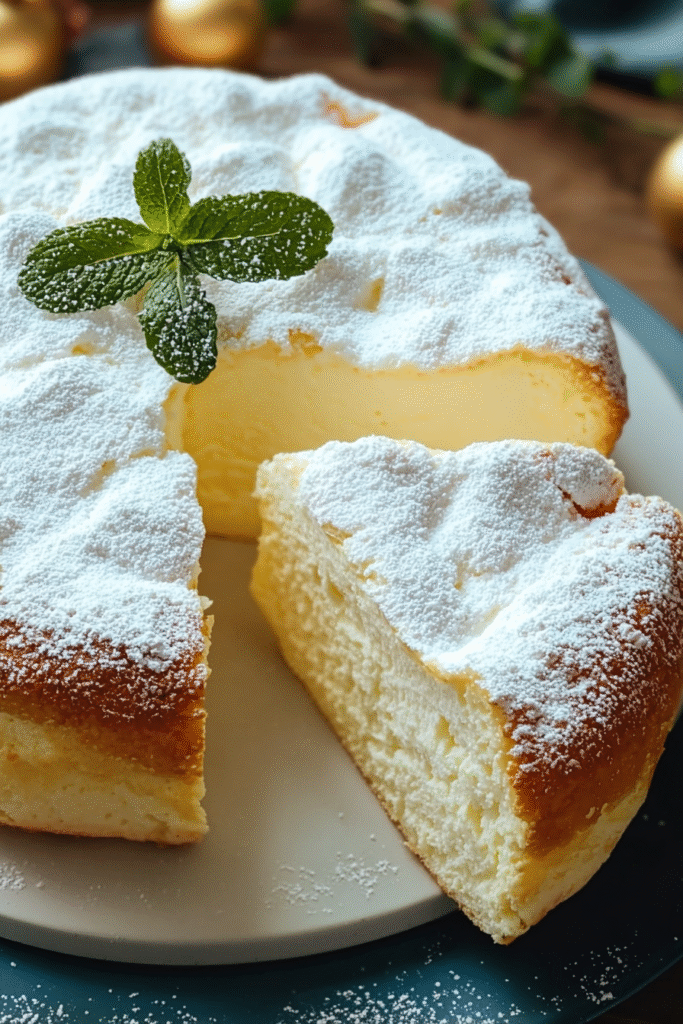
You can even make mini versions in muffin tins for individual servings. They’re crowd-pleasers at showers or office potlucks.
Discover more crowd-favorite ideas like our peach pie cruffins recipe.
Health Benefits of Yogurt Cloud Cake
Lower calorie dessert option
Compared to traditional frosted cakes or cheesecakes, this cake comes in lighter. It has:
- Fewer added fats
- Less refined sugar
- High moisture from yogurt
- No heavy buttercream frosting
It’s naturally sweetened with yogurt and optionally honey, which lowers the overall sugar load. If you’re watching calories but still craving cake, this is your go-to.
Using low-fat yogurt or dairy-free versions also helps reduce calorie count while keeping flavor.
Check out our healthy protein oatmeal cup recipe for more smart dessert swaps.
Probiotics and digestive health
Yogurt-based desserts offer more than taste—they support gut health. Yogurt contains live active cultures (probiotics) that help:
- Improve digestion
- Balance gut bacteria
- Boost immunity
While some probiotic activity may be reduced by baking, using high-quality yogurt still retains many of its nutritional perks. It’s a clever way to serve your family a treat that’s both delicious and packed with health benefits.
Pair it with fiber-rich toppings like berries or oats to make the dessert even more digestion-friendly.
Learn more about the benefits of yogurt and its uses in our what is butter cake made of article.
Storage, Leftovers & Reheating
Refrigerating and freezing the cake
After your yogurt cloud cake has cooled completely, place it in an airtight container and refrigerate. It will stay fresh for 3 to 4 days. Chilling the cake gives it a denser texture, which many find even more enjoyable
To freeze it, wrap slices tightly in plastic wrap, then store in a freezer-safe bag or container. It will keep well for up to 2 months. To thaw, move it to the fridge overnight—avoid microwaving directly, as it may ruin the airy texture.
Check out our apple pie ice cream delight for another freezer-friendly dessert!
Best practices for reheating while retaining texture
Reheating this delicate cake takes care. If you want to serve it warm:
- Use the oven at 275°F for 10–15 minutes.
- Cover with foil to prevent drying.
- Do not microwave unless you’re okay with losing fluffiness.
You can also let the cake come to room temperature naturally and top with warm fruit sauce or syrup. This keeps the light structure intact.
Don’t miss our tips on warming soft desserts without ruining their texture in the how to keep brownies soft and chewy guide.
For more recipes follow me in Facebook and instagram .
FAQs: Light & Fluffy Yogurt Cloud Cake
What makes a yogurt cloud cake fluffy?
The fluffiness comes from stiffly whipped egg whites folded gently into the batter. This incorporates air and gives the cake its cloud-like lift.
Can I use Greek yogurt in a cloud cake?
Absolutely. Greek yogurt creates a richer, denser texture. For a lighter feel, you can thin it with a bit of milk before mixing.
How do I store yogurt cloud cake?
Store it in an airtight container in the fridge for up to 4 days. Freeze slices individually if storing long-term.
Is yogurt cloud cake healthier than traditional cake?
Yes. It has less sugar, less fat, and more protein—especially if made with Greek yogurt. Plus, it doesn’t require heavy frosting.
What can I serve with yogurt cloud cake?
Top with berries, powdered sugar, lemon zest, whipped cream, or drizzle with honey. It’s also lovely with tea or coffee.
Can I make yogurt cloud cake gluten-free?
Yes! Use cornstarch or a gluten-free flour blend instead of regular flour. The result is just as fluffy and delicious.
Conclusion
Light, airy, and absolutely unforgettable, the Light & Fluffy Yogurt Cloud Cake proves that desserts don’t need to be heavy to be satisfying. Whether you’re experimenting with yogurt in baking, watching your calories, or just love a good fluffy treat—this cake delivers on all fronts.
From choosing the right yogurt to mastering the folding technique, this guide has shown you every step to achieve perfection. Serve it cold with fresh fruit, bake it in individual molds, or enjoy it as-is—there’s no wrong way to enjoy a cloud cake.
Discover more dreamy dessert ideas in our chocolate-strawberry hi-hat cupcakes for your next sweet adventure.
Print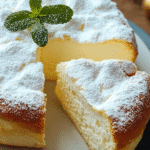
Light & Fluffy Yogurt Cloud Cake
- Total Time: 1 hour 15 minutes
- Yield: 8 slices 1x
- Diet: Vegetarian
Description
This Light & Fluffy Yogurt Cloud Cake is the perfect melt-in-your-mouth dessert made with creamy yogurt and whipped egg whites. With minimal ingredients and a cloud-like texture, it’s an elegant, healthy treat for any occasion.
Ingredients
- 3 large eggs, separated
- ½ cup plain or Greek yogurt
- 3 tablespoons flour or cornstarch (for gluten-free option)
- ¼ cup sugar
- 1 teaspoon vanilla extract
- Pinch of salt
Instructions
- Preheat oven to 300°F (150°C). Prepare a round cake pan lined with parchment paper. Set up a water bath by placing the pan inside a larger pan filled with hot water.
- Mix the yolk base: In a bowl, whisk together egg yolks, yogurt, vanilla, and salt until smooth. Sift in the flour (or cornstarch) and stir until fully combined.
- Whip egg whites: In a separate bowl, beat egg whites until foamy. Gradually add sugar and whip until stiff peaks form.
- Fold egg whites into yolk mixture in 2–3 batches, using a spatula and gentle folding motion to preserve airiness.
- Pour the batter into the prepared pan. Tap lightly to remove air bubbles.
- Bake in water bath for 50–60 minutes. When done, turn off the oven, crack the door, and let the cake cool inside for 15–20 minutes to prevent sinking.
- Chill before serving. Optionally, dust with powdered sugar or top with berries.
Notes
- Use full-fat Greek yogurt for a richer texture or regular yogurt for a softer result.
- Can substitute cornstarch for flour to make it gluten-free.
- Best served chilled with fruit or honey drizzle.
- Avoid overmixing or skipping the water bath to ensure the fluffy texture holds.
- Prep Time: 15 minutes
- Cook Time: 60 minutes
- Category: Dessert
- Method: Baking (Water Bath)
- Cuisine: Japanese-Inspired
Nutrition
- Serving Size: 1 slice (1/8 of cake)
- Calories: 145 kcal
- Sugar: 8g
- Sodium: 60mg
- Fat: 4g
- Saturated Fat: 1.2g
- Unsaturated Fat: 2.4g
- Trans Fat: 0g
- Carbohydrates: 18g
- Fiber: 0.4g
- Protein: 6g
- Cholesterol: 95mg





